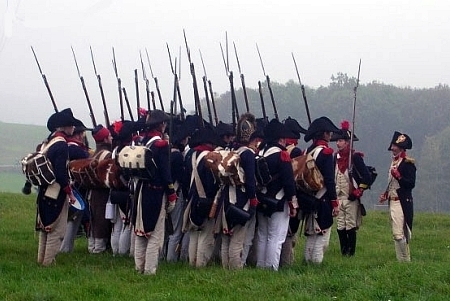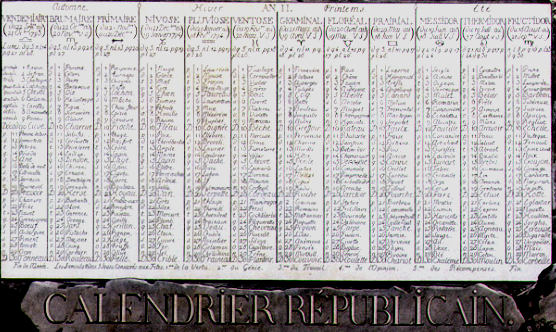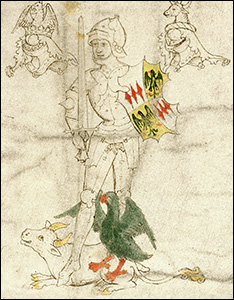


RICHARD NEVILLE, EARL OF WARWICK, called "the king-maker," was the eldest son of Richard Neville, Earl of Salisbury, by Alice, only daughter and heiress of Thomas, the last Montacute Earl of Salisbury. He was born on the 22nd of November 1428, and whilst still a boy betrothed to Anne, daughter of Richard Beauchamp, Earl of Warwick. When her brother's daughter died in 1449, Anne, as only sister of the whole blood, brought her husband the title and chief share of the Warwick estates. Richard Neville thus became the premier earl, and both in power and position excelled his father.
Richard, Duke of York, was his uncle, so when York became Protector in 1453, and Salisbury was made Chancellor, it was natural that Warwick should be one of the council. After the King's [Henry VI] recovery in 1455 Warwick and his father took up arms in York's support. Their victory at St Albans on the 22nd of May was due to the fierce energy with which Warwick assaulted and broke the Lancastrian centre. He was rewarded with the important office of captain of Calais; to his position there he owed his strength during the next five years. Even when York was displaced at home, Warwick retained his post, and in 1457 was also made admiral. He was present in February 1458 at the professed reconciliation of the two parties at St Paul's, London.
During the previous year he had done some good fighting on the march of Calais by land, and kept the sea with vigour; now on his return he distinguished himself in a great fight with Spanish ships off Calais on the 28th of May, and in the autumn by capturing a German salt-fleet on its way to Lubeck. These exploits brought him a prestige and popularity that were distasteful to the home government. Moreover, England was at war neither with Castile nor with the Hanse. Warwick's action may possibly have formed part of some Yorkist design for frustrating the foreign policy of their rivals. At all events there was pretext enough for recalling him to make his defence.
Whilst he was at the court at Westminster a brawl occurred between his retainers and some of the royal household. Warwick himself escaped with difficulty, and went back to Calais, alleging that his life had been deliberately attempted. When in the following year a renewal of the war was imminent, Warwick crossed over to England with his trained soldiers from Calais under Sir Andrew Trollope. But at Ludlow, on the 12th of October, Trollope and his men deserted, and left the Yorkists helpless [cf. Rout of Ludford]. Warwick, with his father, his cousin the young Edward of York, and only three followers, made his way to Barnstaple. There they hired a little fishing vessel. The master pleaded that he did not know the Channel, but Warwick resourcefully took command and himself steered a successful course to Calais. He arrived just in time to anticipate the Duke of Somerset, whom the Lancastrians had sent to supersede him. During the winter Warwick held Calais against Somerset, and sent out a fleet which seized Sandwich and captured Lord Rivers. In the spring he went to Ireland to concert plans with Richard of York. On his return voyage he encountered a superior Lancastrian fleet in the Channel. But Exeter, the rival commander, could not trust his crews and dared not fight.
From Calais Warwick, Salisbury and Edward of York crossed to Sandwich on the 26th of June. A few days later they entered London, whence Warwick at once marched north. On the 10th of July he routed the Lancastrians at Northampton, and took the Kingprisoner. For the order to spare the commons and slay the lords, Warwick was responsible, as also for some later executions at London. Yet when Richard of York was disposed to claim the crown, it was, according to Waurin, Warwick who decided the discussion in favour of a compromise, perhaps from loyalty to Henry, or perhaps from the wish not to change a weak sovereign for a strong. Warwick was in charge of London at the time when Richard and Salisbury were defeated and slain at Wakefield. The Lancastrians won a second victory at St Albans on the 17th of February 1461, possibly through lack of generalship on Warwick's part. But in his plans to retrieve the disaster Warwick showed skill and decision. He met Edward of York in Oxfordshire, brought him in triumph to London, had him proclaimed king [as Edward IV], and within a month of his defeat at St Albans was marching north in pursuit of the Lancastrians. The good generalship which won the victory of Towton may have been due to Edward rather than to Warwick, but the new king was of the creation of the powerful earl, who now had his reward.
For four years the government was centred undisputedly in the hands of Warwick and his friends. The energy of his brother John, Lord Montagu, frustrated the various attempts of the Lancastrians in the north. In another sphere Warwick himself was determining the lines of English policy on the basis of an alliance with France. The power of the Nevilles seemed to be completed by the promotion of George, the third brother, to be Archbishop of York. The first check came with the announcement in September 1464 of the king's secret marriage toElizabeth Woodville. This was particularly distasteful to Warwick, who had but just pledged Edward to a French match. For the time, however, there was no open breach. The trouble began in 1466, when Edward first made Rivers, the Queen's father, treasurer, and afterwards threw obstacles in the way of an intended marriage between Warwick's daughter Isabel andGeorge of Clarence, the King's own next brother. Still in May 1467 Warwick went again with the king's assent to conclude a treaty with France. He returned to find that in his absence Edward, under Woodville's influence, had committed himself definitely to the Burgundian alliance.
Warwick retired in dudgeon to his estates, and began to plot in secret for his revenge. In the summer of 1469 he went over to Calais, where Isabel and Clarence were married without the king's knowledge. Meantime he had stirred up the rebellion of Robin of Redesdale in Yorkshire; and when Edward was drawn north, Warwick invaded England in arms. The King, outmarched and outnumbered, had to yield himself prisoner, whilst Rivers and his son John were executed. Warwick was apparently content with the overthrow of the Woodvilles, and believed that he had secured Edward's submission. In March 1470, a rebellion in Lincolnshire gave Edward an opportunity to gather an army of his own. When the King alleged that he had found proof of Warwick's complicity, the earl, taken by surprise, fled with Clarence to France. There, through the instrumentality of Louis XI, he was with some difficulty reconciled toMargaret of Anjou, and agreed to marry his second daughter to her son.
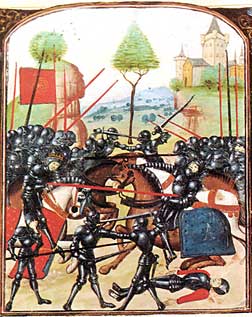 In September Warwick and Clarence, with the Lancastrian lords, landed at Dartmouth. Edward in his turn had to fly overseas, and for six months Warwick ruled England as Lieutenant for Henry VI, who was restored from his prison in the Tower to a nominal throne. But the Lancastrian restoration was unwelcome to Clarence, who began to intrigue with his brother. When in March 1471 Edward landed at Ravenspur, Clarence found an opportunity to join him. Warwick was completely outgeneralled, and at Barneton the 14th of April was defeated and slain.
In September Warwick and Clarence, with the Lancastrian lords, landed at Dartmouth. Edward in his turn had to fly overseas, and for six months Warwick ruled England as Lieutenant for Henry VI, who was restored from his prison in the Tower to a nominal throne. But the Lancastrian restoration was unwelcome to Clarence, who began to intrigue with his brother. When in March 1471 Edward landed at Ravenspur, Clarence found an opportunity to join him. Warwick was completely outgeneralled, and at Barneton the 14th of April was defeated and slain.
Warwick has been made famous by Lytton as "The Last of the Barons." The title suits him as a great feudal lord, who was a good fighter but a poor general, who had more sympathy with the old order than with the new culture. But he was more than this. He had some of the qualities of a strong ruler, and the power to command popularity. He was a skilled diplomatist and an adroit politician. These qualities, with his position as the head of a great family, the chief representative of Beauchamp, Despenser, Montacute and Neville, made him during ten years "the king-maker." Warwick's only children were his two daughters. Anne, the younger, was married after his death to Richard of Gloucester, the future Richard III.
Richard, Duke of York, was his uncle, so when York became Protector in 1453, and Salisbury was made Chancellor, it was natural that Warwick should be one of the council. After the King's [Henry VI] recovery in 1455 Warwick and his father took up arms in York's support. Their victory at St Albans on the 22nd of May was due to the fierce energy with which Warwick assaulted and broke the Lancastrian centre. He was rewarded with the important office of captain of Calais; to his position there he owed his strength during the next five years. Even when York was displaced at home, Warwick retained his post, and in 1457 was also made admiral. He was present in February 1458 at the professed reconciliation of the two parties at St Paul's, London.
During the previous year he had done some good fighting on the march of Calais by land, and kept the sea with vigour; now on his return he distinguished himself in a great fight with Spanish ships off Calais on the 28th of May, and in the autumn by capturing a German salt-fleet on its way to Lubeck. These exploits brought him a prestige and popularity that were distasteful to the home government. Moreover, England was at war neither with Castile nor with the Hanse. Warwick's action may possibly have formed part of some Yorkist design for frustrating the foreign policy of their rivals. At all events there was pretext enough for recalling him to make his defence.
Whilst he was at the court at Westminster a brawl occurred between his retainers and some of the royal household. Warwick himself escaped with difficulty, and went back to Calais, alleging that his life had been deliberately attempted. When in the following year a renewal of the war was imminent, Warwick crossed over to England with his trained soldiers from Calais under Sir Andrew Trollope. But at Ludlow, on the 12th of October, Trollope and his men deserted, and left the Yorkists helpless [cf. Rout of Ludford]. Warwick, with his father, his cousin the young Edward of York, and only three followers, made his way to Barnstaple. There they hired a little fishing vessel. The master pleaded that he did not know the Channel, but Warwick resourcefully took command and himself steered a successful course to Calais. He arrived just in time to anticipate the Duke of Somerset, whom the Lancastrians had sent to supersede him. During the winter Warwick held Calais against Somerset, and sent out a fleet which seized Sandwich and captured Lord Rivers. In the spring he went to Ireland to concert plans with Richard of York. On his return voyage he encountered a superior Lancastrian fleet in the Channel. But Exeter, the rival commander, could not trust his crews and dared not fight.
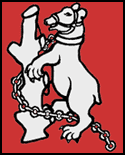 Bear and Ragged Staff — Badges of Richard Neville |
For four years the government was centred undisputedly in the hands of Warwick and his friends. The energy of his brother John, Lord Montagu, frustrated the various attempts of the Lancastrians in the north. In another sphere Warwick himself was determining the lines of English policy on the basis of an alliance with France. The power of the Nevilles seemed to be completed by the promotion of George, the third brother, to be Archbishop of York. The first check came with the announcement in September 1464 of the king's secret marriage toElizabeth Woodville. This was particularly distasteful to Warwick, who had but just pledged Edward to a French match. For the time, however, there was no open breach. The trouble began in 1466, when Edward first made Rivers, the Queen's father, treasurer, and afterwards threw obstacles in the way of an intended marriage between Warwick's daughter Isabel andGeorge of Clarence, the King's own next brother. Still in May 1467 Warwick went again with the king's assent to conclude a treaty with France. He returned to find that in his absence Edward, under Woodville's influence, had committed himself definitely to the Burgundian alliance.
Warwick retired in dudgeon to his estates, and began to plot in secret for his revenge. In the summer of 1469 he went over to Calais, where Isabel and Clarence were married without the king's knowledge. Meantime he had stirred up the rebellion of Robin of Redesdale in Yorkshire; and when Edward was drawn north, Warwick invaded England in arms. The King, outmarched and outnumbered, had to yield himself prisoner, whilst Rivers and his son John were executed. Warwick was apparently content with the overthrow of the Woodvilles, and believed that he had secured Edward's submission. In March 1470, a rebellion in Lincolnshire gave Edward an opportunity to gather an army of his own. When the King alleged that he had found proof of Warwick's complicity, the earl, taken by surprise, fled with Clarence to France. There, through the instrumentality of Louis XI, he was with some difficulty reconciled toMargaret of Anjou, and agreed to marry his second daughter to her son.
 In September Warwick and Clarence, with the Lancastrian lords, landed at Dartmouth. Edward in his turn had to fly overseas, and for six months Warwick ruled England as Lieutenant for Henry VI, who was restored from his prison in the Tower to a nominal throne. But the Lancastrian restoration was unwelcome to Clarence, who began to intrigue with his brother. When in March 1471 Edward landed at Ravenspur, Clarence found an opportunity to join him. Warwick was completely outgeneralled, and at Barneton the 14th of April was defeated and slain.
In September Warwick and Clarence, with the Lancastrian lords, landed at Dartmouth. Edward in his turn had to fly overseas, and for six months Warwick ruled England as Lieutenant for Henry VI, who was restored from his prison in the Tower to a nominal throne. But the Lancastrian restoration was unwelcome to Clarence, who began to intrigue with his brother. When in March 1471 Edward landed at Ravenspur, Clarence found an opportunity to join him. Warwick was completely outgeneralled, and at Barneton the 14th of April was defeated and slain.Warwick has been made famous by Lytton as "The Last of the Barons." The title suits him as a great feudal lord, who was a good fighter but a poor general, who had more sympathy with the old order than with the new culture. But he was more than this. He had some of the qualities of a strong ruler, and the power to command popularity. He was a skilled diplomatist and an adroit politician. These qualities, with his position as the head of a great family, the chief representative of Beauchamp, Despenser, Montacute and Neville, made him during ten years "the king-maker." Warwick's only children were his two daughters. Anne, the younger, was married after his death to Richard of Gloucester, the future Richard III.
Excerpted from:
Encyclopedia Britannica, 11th Ed. Vol XVIII.
Cambridge: Cambridge University Press, 1910. 340.

